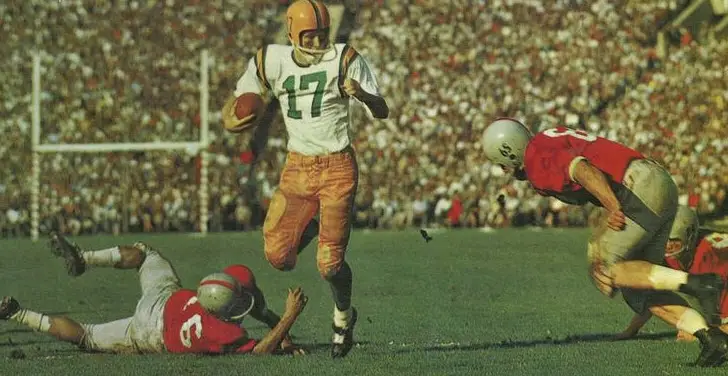
Jack Crabtree in the 1958 Rose Bowl.
Win or lose the Rose Bowl on January 2, this year’s Oregon squad has already earned a special distinction: one of the 20 greatest seasons in the history of a team that has been playing football since 1894. After all, this year’s regular season produced only the Ducks’ fifth outright conference title (along with 1994, 2001, 2009 and 2010) and only the team’s seventh 10-win season. Where in that top-20 the 2011 squad will finish is still to be determined. If they win in Pasadena, one can arguably put this year’s campaign in a tie with 2001’s Fiesta Bowl-winning team for the second greatest. If the Rose Bowl winds up in another loss, it may still be in the top ten all-time, but just barely.
Meanwhile, here is an attempt to rank the other 19 greatest seasons in team history. Of course these rankings aren’t written in stone. Like lists of great movies or even college football’s various top 25 polls, this is merely a matter of opinion. All that said, it would be hard for any Duck fan to question the top few listings. So here goes…
No. 1 – 2010: Undefeated and Playing For The Title
There is no deliberation necessary for the top spot. When you go 12-0 for the school’s first regular season with all wins, no losses and no ties since 1895, and then earn a slot in the national championship game, it takes less than a millisecond to say it’s the greatest campaign in Oregon football history. What’s more, it took the greatest college athlete of our time, as well as an unpunished pay-for-play scheme by that player and his father, to keep the Ducks from the title. Even then, the refs had to give a tackled opposing player the right to keep running in the last minute of the game for Oregon to be vanquished. Losing the title game was the ultimate combination of pride and disappointment. But make no mistake: announcer Jerry Allen‘s famous call from 1994, “Kenny Wheaton‘s gonna score!” now has an equal in his joyful sobs as the clocked ticked to zero on a 12-0 season in Corvallis.
No. 2 – 2001: Fiesta del Harrington
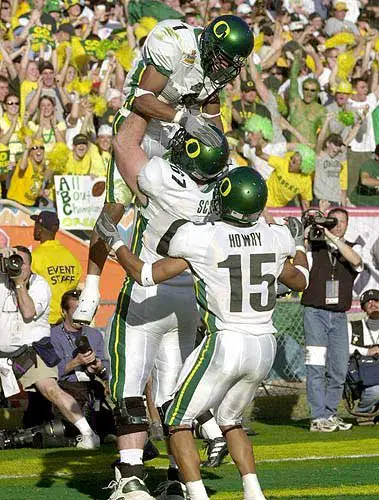
Fiesta Bowl celebrating…
Joey Harrington and company gave Duck fans the other true crowning moment in the history of the program. On a sunny January afternoon in Tempe, Arizona, the nation watched Oregon prove what most already knew: that the nation’s consensus #2 ranked team (in the Associated Press and ESPN/USA Today coaches polls) deserved to play Miami for the national championship. An appalling computer malfunction in the BCS computers prevented Oregon from playing in that game, yet few Duck fans were bitter after Harrington’s spectacular day obliterated a heavily favored Colorado team. If Oregon has never won a national title, we can still call our beloved
Ducks a two-time runner-up. After the bowl season, the AP ranked Oregon second over a Nebraska team pummeled by Miami for the title.
No. 3 – 1916: Only Rose Bowl Win (so far)
Maybe it was gangly guys playing in leather helmets who wouldn’t even make their teams’ third string today. Maybe it was so long ago that not even our grandparents were alive for the game. But 1916 still stands as the last time the Oregon Ducks were victorious in the Rose Bowl. This year’s squad has the opportunity to change that, and a win this year undoubtedly would place 2011 ahead of this Pasadena win. Even if the last Rose Bowl victory had happened in 2000 BC, however, it would still be a Rose Bowl win. For all the success Oregon has achieved in the last 20 years, January bowl victories are still the missing piece.
No. 4 – 1994: A Transformed Team
If this were a ranking of greatest watershed moments in Oregon history, 1994 would probably be in the #1 slot. Even the 12-0 season and title-game appearance in 2010 may not compare to the explosion of joy Oregon fans experienced at making it to the team’s first Rose Bowl in 37 years. By 1994, the program and its supporters had all but lost hope that Oregon could compete on the biggest stages. Toilet bowls like the Independence or the Freedom seemed to perhaps be the ceiling for Rich Brooks‘ team. And then, WHAM! Make your plane reservations for Pasadena! And all this after a 1-2 start that had fans calling for Rich Brooks to be fired.

Kenny Wheaton’s gonna score!
While the final score of 38-20 in the Rose Bowl could have been closer, once again Oregon was playing one of the nation’s best teams in undefeated Penn State. As it turned out, the Ducks had the moral edge, for one of the Nittany Lions’ assistant coaches that day in the Rose Bowl was Jerry Sandusky, the accused child molester. But on the field, the Ducks made a valiant effort only to miss some key opportunities, like being inside the 10-yard line twice in the first half without yielding any points. Even then, the game was tied at 14 in the third quarter before a few key plays gave Penn State late-game breathing room. Oregon fans may have come away disappointed with the result, but pride that day among those wearing green and yellow was at an all-time high.
And the program has never been the same, with only one losing season in the 17 years since. In the 17 years prior to 1994, by comparison, there were nine losing campaigns. In the 17 seasons before that, 11 of them were losing campaigns. Maybe it was another year before Phil Knight and Nike got involved, and a few seasons before the metamorphosis really took hold. Yet 1994 is unequivocally the point at which the Ducks found that next gear and moved into the fast lane of college football.
No. 5 – 1957: Rose Squeaker Against No.1
Only because of the Pac-8’s no repeat rule did Oregon play in Pasadena on New Year’s Day in 1958; otherwise it would have been the Beavers, who bested the Ducks in that year’s Civil War. Yet once head coach Len Casanova’s team reached the Rose Bowl, they did something heroic: They played the #1-ranked team and eventual national champion, Ohio State, to a three-point game, losing 10-7. It would have only taken one play to turn out differently – a much regretted dropped touchdown pass by an Oregon receiver – to give the Ducks one of the biggest upsets in college football history.
So let’s give a tip of the cap to players like quarterback Jack Crabtree, and to two-way stars like Jack Morris, who led the team in rushing that year and in interceptions the following campaign. Too often we celebrate Oregon’s glories as if they all came from the 1990s forward. But there would never be a Chip Kelley without Mike Bellotti and Rich Brooks, and those men would never have achieved what they did without the example of Len Casanova.
No. 6 – 2009: Boise to Pasadena
The season, and Chip Kelly’s head coaching career, could not have started more disastrously with a loss at Boise State and LeGarrette Blount‘s punch heard ’round the world. Yet, like the Rose Bowl campaign of 1994, early-season adversity seemed to rally the players together to play great football.
It’s easy to forget about 2009 because of the undefeated season and BCS title game appearance that game a year later. Duck fans also sometimes forget, now that we’ve had Darron Thomas under center for two years, what a superb quarterback Jeremiah Masoli was. With apologies to signal caller Reggie Ogburn, who helmed Rich Brooks’ teams in 1979 and 1980, Masoli has to be considered the greatest running QB in Oregon history. And yet he was able to hit Jeff Maehl down the sidelines with regularity. Masoli was an excellent closer, too. Remember the comeback against Arizona on the road, when their fans began prematurely charging the field in celebration only to see the Ducks eke out a victory?
Oregon has never had an easy time of it opponent-wise in Pasadena, and against Ohio State the Ducks saw the difference between having a very good junior college transfer under center and a superstar blue-chip recruit. Terrelle Pryor almost went to Oregon instead of Ohio State, but chose the Buckeys over the Ducks and Nittany Lions. And the Duck defense could never quite control Pryor’s combination of passing and running. Yet Oregon still could have won the game if not for one or two disastrous plays, especially Blount’s third-quarter fumble into the end zone that resulted into a touchback for Ohio State. And even in losing the game, Oregon fans had to like what they saw from a first-year head coach.
No. 7 – 2000: Texas Sized Top 10 Finish
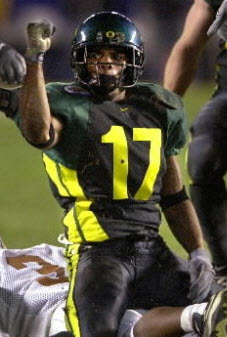
Rashad Bauman
Although a Holiday Bowl victory isn’t quite the same as winning in January, there’s no doubt this Joey Harrington-led squad was special. If this were a list of Oregon’s most talented teams, 2000 would be ranked even higher. Only close losses at Wisconsin and at Oregon State blemished this team’s otherwise stellar achievements. 2000 brought one of the Ducks greatest regular season victories: a 56-55 double-overtime thriller against Arizona State. It saw the Ducks soundly defeat that year’s Rose Bowl winner, Washington. And then there’s the classic Holiday Bowl game itself.
Oregon had a tall order against a Texas Longhorns team stocked with blue-chip future pro players like receiver Roy Williams and quarterback Chris Simms (son of Super Bowl winning QB Phil Simms). The game was close all the way. But Oregon behind Harrington as well as stars like Maurice Morris, Keenan Howry and cornerback Rashad Bauman, played fearlessly and joyfully. They would not be denied. If one could bottle the refuse-to-lose mentality of the 1999-2001 Harrington-led era and give it to the current LaMichael James/Darron Thomas era, there would likely be at least one national title in the Casanova Center display case. As it was, the Holiday Bowl victory gave Oregon its first-ever year-end Top 10 ranking.
No. 8 – 1989: Birth of A Winning Program
If one were only looking at the game results – a regular season at 7-4 and a victory in the Poulan Weed Eater Independence Bowl in frigid, blighted Shreveport, Louisiana – this season might not seem to rank so high.
Yet except for perhaps 1994’s Rose Bowl campaign, no other season brought such euphoria. 1989 marked Oregon’s first trip to a bowl game since the 1960 Sun Bowl. It was the point at which the Ducks ceased nearly four decades of disappointment and showed the college football world that there would be a new marquee player on the national stage. In the 20 seasons before the 1989 campaign, Oregon failed to post a winning record 15 times. In the 20 seasons after 1989, the Ducks had a losing season once.
But it wasn’t just that the Ducks won instead of losing, or that they made it to postseason instead of staying home. It was how they did it: behind the heroics of Bill Musgrave. Joey Harrington is better known today as “Captain Comeback”, the possessor of some intangible magic that could grasp victory from the jaws of defeat. But Musgrave is the Chuck Berry to Harrington’s Elvis, the man at the center of a rebirth that fully culminated after he left. Musgrave, like Rich Brooks, isn’t just able to claim some credit for the victories happening while he was on the Oregon sideline, but for all that came afterward.
No. 9 – 2007: Dixon In The Driver’s Seat
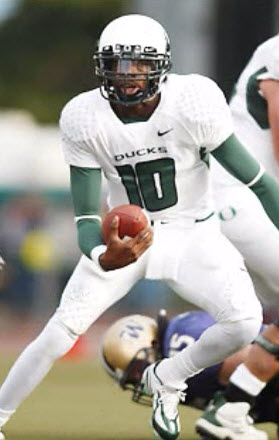
Dennis Dixon in the Storm Trooper uniform chewing up the Huskies.
How can you rank a season that ended with a Sun Bowl over one that ended with a Rose Bowl? Well, 2007 was no ordinary season even by the roller-coaster standards of sport. The regular season record may only have been 8-4 and the final destination may have been somewhat lowly El Paso rather than glorious Pasadena, but consider this about 2007: It was the first time that Oregon could make a legitimate argument as the best team in the nation. It was the first time the Ducks reached as high as the #2 ranking in the regular season. And most of all, it was the first time Oregon played with a true Heisman front-runner. “Dennis Dixon is in the driver’s seat for the Heisman Trophy,” Kirk Herbstreit said in a November ESPN broadcast that year. “It’s his to lose.”
Think of three games from that season: the dramatic wins against USC and Arizona State, both ranked in the top 10 when they came to Eugene but not when they left; or the demolishing of college football’s all-time winningest team, Michigan, before more than 105,000 in storied Michigan Stadium. If not for a torn knee ligament, suffered against ASU and aggravated against Arizona, it’s possible—no, probably—that what Oregon achieved in 2010 it would have equaled or even surpassed in 2007. And all this without even talking yet of what may be Oregon’s best running back ever: Jonathan Stewart, who finished his career as a Duck by exploding in the 2007 Sun Bowl for 253 yards.
No. 10 – 1995: First Ever Second-Straight January Date
Like a talented child overshadowed by an older sibling, 1995 routinely takes a back seat to 1994. The euphoria over a first Rose Bowl in 37 years had come only one season prior. Rich Brooks, the man who led Oregon for 18 seasons, was gone, with an unproven assistant coach taking over. Gone too was quarterback Danny O’Neil, who had led dramatic comebacks against Washington, Arizona and Oregon State the year prior.
Yet one could argue that the 1995 squad had one thing going for it over 1994: they were an even better football team. In all three games to begin the season Oregon posted come-from-behind wins, including nail biting finishes against Illinois and UCLA secured by Jaiya Figueras (via a fumble-recovery touchdown against the Illini and stopping a go-ahead Bruins touchdown on the last play of the game). Defensive coordinator Charlie Waters, a former Dallas Cowboys all-pro who left the team at season’s end following his young son’s tragic death, had Gang Green giving up even fewer scores and yards than Nick Alliotti‘s squad the year before.
And while the Cotton Bowl blowout loss against Colorado was a bitter pill to swallow, it was the first time Oregon had made it to back-to-back marquee January bowl games. And the aftermath is another part of the Oregon-as-powerhouse-program creation story: It’s when deep pocketed alumnus Phil Knight committed his resources to helping the Ducks compete off the field with matchless facilities.
No. 11 – 1919: Return to Pasadena
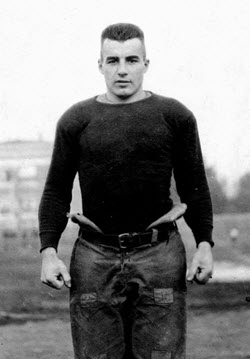
Shy Huntington
This is probably the most forgotten great season in Oregon’s history. Not only is it decades before the modern era began, but unlike 1917, the Ducks weren’t able to secure Rose Bowl victory, losing 7-6 to Harvard.
Yet this was a special season for the Ducks. It was the first year Oregon played in Hayward Field, where the team would stay until 1967. The team was coached by Shy Huntington, who as a player had led the Rose Bowl-winning 1916 squad. All the while, Oregon’s administration was shaming Huntington by trying to lure former Ducks coach Hugo Bezdek out of his current job at Penn State and back to Eugene. Yet Huntington coached his brother, Hollis, to a stellar season that included a four-touchdown performance against Idaho. That year the conference crown came down to a Ducks-Huskies showdown, and Oregon’s Skeet Manerud led his team back from a late-game deficit with two touchdowns for a 24-13 victory at Multnomah Stadium in Portland.
In the Rose Bowl, Oregon outplayed Harvard, but four attempts at a game-winning field goal came up short. Final score: 7-6 Crimson. The last attempt was so close, in fact, that the scoreboard operator gave Oregon credit for the kick before being overruled by the referee.
No. 12 – 2008: Spoiler and Swansong
As the regular season reached its final game in 2008, there seemed to be plenty reason for disappointment. The Civil War was going to decide a Rose Bowl slot, but it was the Beavers who were playing for Pasadena, not the Ducks. This after a campaign with bitter losses against Boise State, USC and Cal and an early-season curve-ball with starter Justin Roper going out with injury.
Then three things happened. First, Oregon played one of its most inspired games of Mike Bellotti’s 14-year tenure, routing Oregon State 65-38 on a host of big plays by the likes of Jeremiah Johnson, Ed Dickson and the “D Boyz” defensive backfield of Patrick Chung, Jairus Byrd, TJ Ward and Walter Thurmond III (Oregon’s greatest collection of corners and safeties ever). By this time, Jeremiah Masoli had solidified himself in the starting quarterback’s role, and the team elevated its level of play as a result.
Second, Bellotti announced after the Civil War that he would be retiring as coach to become athletic director of the school. It cast the season in a different light, knowing that it marked the all-time winningest Duck coach’s exit. Luckily Oregon had won three straight to end the season, earning a Holiday Bowl birth. That enabled the third part of the late-season story, an all-too-elusive bowl win, and against a very talented Oklahoma State squad. As a result, the Ducks finished the year in the Top 10 for only the fourth time in school history—all of which had come under Bellotti.
No. 13 – 2005: Clemens injured, but still 10-1

Kellen Clemens
You’d think finishing with just one regular season loss would earn a Pac-10 team a BCS bowl slot, as has happened for Stanford the past two years or any number of other examples. But as they had been in 2001, the Ducks were betrayed by the inequities of the BCS system.
Oregon finished 10-1 in 2005, its only loss to the defending national champion and #1-ranked team, USC. All this came despite losing starting quarterback Kellen Clemens to a season ending injury with three games left, a combination of Dennis Dixon and Brady Leaf taking his place. But the January bowls shied away from Oregon after Clemens went down, fearing poor TV ratings (a statistic Oregon has since disproven as one of the highest rated bowl teams).
So despite having a better record than two BCS-bowl-bound teams ahead of them (Ohio State and Notre Dame), the Ducks accepted a Holiday Bowl invitation. A close loss to Oklahoma ensued when an opportunity to take the lead with Oregon inside the 10-yard line gave way to a Leaf interception. Even so, Oregon finished with only its third Top 10 finish in history, earning the #10 slot in both the AP and coaches’ polls.
No. 14 – 1963: Bowl win for Cas
This is one of a numerous Len Casanova-coached teams from the late 1950s and early ’60s that could have made the list of top Oregon seasons. Besides the Rose Bowl team of ’57 there was the 8-2 squad of 1959, which saw the Ducks booted from the PCC only to enact their revenge against “nonconference” opponents like Stanford and Cal. The team’s only losses were 13-12 to Washington and 15-7 to the Beavers; had one of them been a victory, Oregon probably would have played in another January game such as the Cotton Bowl or Orange Bowl, as two-loss teams frequently do today. Casanova’s 1960 team went 7-3-1 and earned a Liberty Bowl invitation (a 41-12 loss ensued). The 1962 squad went 6-3-1, its only losses coming to top teams: Texas, Ohio State and a Beaver program at its zenith.
But it was in 1963 that Casanova’s teams finally tasted bowl victory, and it was also the senior season for two of its greatest players, each of which would go on to Hall of Fame careers in the NFL: Mel Renfro and Dave Wilcox. That year also included stars like and the “Firehouse Four” backfield of quarterback Bob Berry with rushers Renfro, Lu Bain and Larry Hill en route to a 6-3-1 campaign. The year also included some big victories: a 35-0 shutout of West Virginia, a dramatic come-from-behind win against Indiana, and a 31-14 whipping of the Beavers.
But it was the final game, a Sun Bowl win against SMU, that gave the Ducks what would be the team’s only bowl win between the 1916 and 1989 seasons. Considering Renfro’s super-stardom, one might be tempted to call this a one-man team at times. Yet Renfro actually was injured and didn’t play in the Sun Bowl win. When Casanova was coach, Oregon was always a true team.
No. 15 – 1998: Pre-injury perfection

Reuben Droughns
Coming between the mid-90s years that brought two January bowl appearances and the late ’90s/early 2000s of the Joey Harrington years, it’s easy to forget what a talented squad Oregon had in 1997 and 1998. It started with quarterback Akili Smith and running back Reuben Droughns in the backfield, and receiver Pat Johnson on the flank. The defense included linebacker Peter Sirmon and cornerback Rashad Bauman.
The 1997 Ducks could easily have been ranked here. After all, it’s this team that won that year’s Las Vegas Bowl in a 41-13 trouncing of Air Force, while the ’98 team lost a Holiday Bowl to Colorado. Yet this can be misleading. Only because of Droughns’ season-ending injury in 1998, along with other season-ending injuries to key starters like Peter Sirmon, did Oregon find itself outside of January-bowl glories. The season began with a blowout heard ’round the college football world, a 48-14 annihilation of Nick Saban’s Michigan State Spartans.
It was only the first of several games in which Droughns rushed for more than 200 yards. And Smith had learned to couple his impressive running skills with pinpoint passing, hitting not just Pat Johnson but Damon Griffin with regularity. For perhaps the first time since the early ’70s teams of Fouts and Rashad, Oregon had two legitimate Heisman contenders playing together in the same backfield.
It’s true that the season-ending Holiday Bowl loss was a downer, but the real tragedy had occurred several weeks earlier when Droughns broke his leg against UCLA. A team that seemed all but unstoppable at 5-0 entering the game but went 3-4 afterward to finish 8-4. Yet this is a season mark that ought to have an asterisk by it, and final results are only one way (albeit the dominant one) of measuring a team’s legacy. Particularly in light of the successes that came Oregon’s way in the Harrington, Masoli and Darron Thomas years that followed, the Akili Smith years were a harbinger of what was to come in terms of offensive juggernauts led by dual-threat options at the QB position. If only Smith could have had the keys to Chip Kelly’s spread offense.
No. 16 – 1948: Van Brocklin’s Cotton
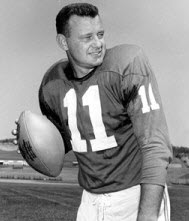
Norm Van Brocklin in the NFL.
Who was the greatest Oregon quarterback of all-time? It might not be Dan Fouts or Joey Harrington but Norm Van Brocklin. In 1949, Oregon was co-champion of the Pacific Coast Conference (forerunner of today’s Pac-12) with Cal, and the conference representative in the Rose Bowl was selected via conference vote. Cal won 7-3, most notably getting votes from Washington and then-members Idaho and Montana, sealing a lifetime of acrimony between the Ducks and Huskies. Van Brocklin unabashedly shed tears upon hearing that Oregon wouldn’t play in the Rose Bowl, especially because in those days it was usually a trip to Pasadena or no bowl at all. This time, though, and almost equally prestigious bowl produced an invitation.
In the Cotton Bowl on New Year’s Day 1949, Oregon was a favorite even though SMU had that year’s Heisman Trophy winner, Doak Walker. Instead, Mustangs led 14-0 before Van Brocklin led Oregon on two fourth-quarter touchdown drives. In the end, Oregon led in most statistical categories but the score was 21-13 SMU.
Within three years of his final season at Oregon, Van Brocklin was leading the Los Angeles Rams to the NFL championship, a feat he would equal in 1960 with the Philadelphia Eagles, making him that year Oregon’s first and only National Football League MVP winner.
No. 17 – 1970: Frei’s Great Backfield
Speaking of teams that should be measured in ways beyond their final record, the 6-4-1 campaign head coach Jerry Frei‘s team posted in the 1970 comes with it an over-sized presence that must be acknowledged.
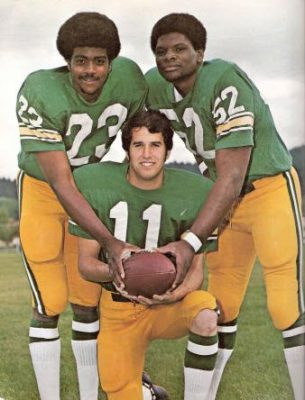
Bobby Moore, Tom Graham, and Dan Fouts in 1971.
The team was led by two quarterbacks that year, senior Tom Blanchard and sophomore Dan Fouts. Blanchard started but was perennially injured, enabling the future Pro Football Hall of Fame member to take the reigns. Playing at running back that year was Ahmad Rashad (known then as Bobby Moore), who became the first Ducks rusher to surpass the 1,000-yard mark for total yards gained on the ground in a season. There was also talent at receiver with Bob Newland, who matched Rashad’s feat with the Ducks’ first-ever 1,000-yard receiving year. In fact, after the first three weeks of the season, Oregon led the nation in passing.
While Oregon lacked the depth necessary to win game after game, or to compete with top teams, at times they possessed brilliance. Rashad was as talented as any running back in America, and in a loss to Stanford and that year’s Heisman winner, Jim Plunkett, Fouts threw for more yards. The high points came against the two Los Angeles schools. On the road against UCLA came what may be a candidate for greatest Ducks regular-season win of all-time, coming back from 40-21 with 4:28 remaining to win 41-40 on a touchdown reception by Glass thrown by Fouts after the quarterback had suffered a concussion.
Two weeks later, a 10-7 win over mighty USC at Autzen had Oregon ranked #16 and fans dreaming of a Rose Bowl—until a heartbreaking 25-23 loss against Washington. Still, 1971 was the apex of the Frei/Fouts/Rashad era, one that ended too soon for Frei and to Oregon’s detriment, but one that also produced moments of matchless glory.
No. 18 – 1990: Musgrave’s Magic
Though this Brooks-coached, Musgrave-led team tasted bitter defeat in a 32-31 Freedom Bowl loss, these Ducks also posted some remarkable victories along the way. The biggest was a 32-16 defeat of then fourth-ranked BYU and that year’s Heisman Trophy winner, Ty Detmer (avenging a comeback win by the Tigers the year before in Provo). Musgrave’s final game at Autzen Stadium was also magical, with the quarterback’s last throw a game-winning touchdown strike against UCLA. It was the first time since 1963 that Oregon had posted eight wins in a season. The team’s only regular season losses were to bowl-bound Arizona and California teams, and to that year’s Rose Bowl winner, Washington.
In the Freedom Bowl, Musgrave played a spectacular game, but turnovers hurt the Ducks as well as a questionable call at game’s end, when a potential game-winning two point conversion was caught in the end zone by Michael McClellan but officials ruled the ball hadn’t crossed the plane of the goal line.
No. 19 – 1999: Birth of Captain Comeback

AJ Feeley
It wasn’t the first or the last time Oregon won the Sun Bowl, but this season was something more. It was a year that began with A.J. Feeley at quarterback—and playing at a very high level, among the nation’s passing leaders before injury—and ended with Joey Harrington leading the Ducks to what would become the signature of his era: comeback victories. During consecutive weeks in 1999, for example, Harrington led Oregon to thrilling wins after trailing with only seconds remaining.
Feeley, to his credit, would go on to be the better and more accomplished NFL quarterback, yet 1999, to Harrington’s, marked the beginning of what was then the greatest three-year run in team history. The Sun Bowl win against Minnesota found the Ducks trailing 20-17 with less than two minutes left when Harrington found Howry from 10 yards out. And a Ducks legend was born.
HONORABLE MENTION
1933: A conference co-championship with Stanford but no Rose Bowl—or any bowl.
1980: Option quarterback Reggie Ogburn led Oregon to a 6-3-2 season that included a tie with then #1-ranked USC.
1997: Las Vegas Bowl-winning season in which Akili Smith cemented the starting quarterback’s job, Pat Johnson caught countless touchdown passes and Saladin McCullough ushered in an era of great running backs.
Brian Libby
Portland, Oregon
Related Articles:
Brian Libby is a writer and photographer living in Portland. A life-long Ducks football fanatic who first visited Autzen Stadium at age eight, he is the author of two histories of UO football, “Tales From the Oregon Ducks Sideline” and “The University of Oregon Football Vault.” When not delving into all things Ducks, Brian works as a freelance journalist covering design, film and visual art for publications like The New York Times, Architect, and Dwell, among others.
